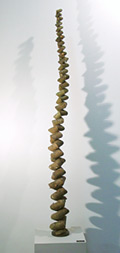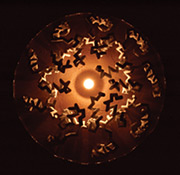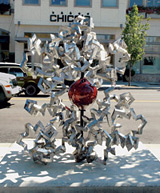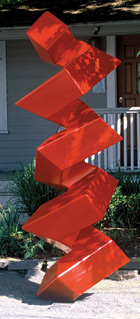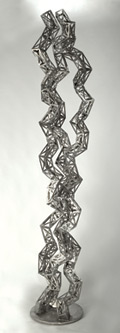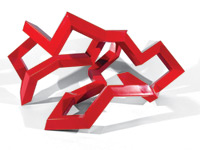Gallery: Julian Voss-Andreae
Unveiling the three-dimensional structure of proteins thrills scientists. While the potential for understanding the folding and function of enzymes is truly exciting by itself, exploring macromolecule structures also satisfies a more fundamental urge: to see the invisible.
Scientists are sometimes so moved that they aspire to turn their discoveries into works of art. Rockefeller University professor Rod MacKinnon, for example, believes his potassium ion channel structure would make a great lamp.
While many scientists recognize the artistry of Nature within this sub-microscopic realm, artists less often embrace biochemical entities as a subject for art. Julian Voss-Andreae is one who does. A sculptor with roots in physics, he creates art inspired by the three-dimensional structures of proteins.
Voss-Andreae first learned about proteins as a graduate student in physics. In 2000 he left his native Germany for Oregon, changing careers to pursue his interest in the mechanisms of the world through art rather than science. He gravitated to proteins as a subject matter, intrigued by how fundamental and universal they are to life. He has noticed that most artists focus on anthropocentric subjects, but he endeavors to "take that attitude out of art and use a more scientific view." He adds, "Proteins were built before we were."
|
|
||||||
The beauty of proteins first seduced Voss-Andreae. He chose subjects that appeal to his aesthetics, like Bovine Pancreatic Trypsin Inhibitor (BPTI) or Green Fluorescent Protein (GFP). He now prefers proteins with functions that interest him. When intrigued by protein in a research or news article, he will look up the structure in the protein data bank to see what it looks like–structures that often come from x-ray crystallography experiments such as those done at the Stanford Synchrotron Radiation Laboratory. Often his artistic choices reflect the protein's function. His sculpture of a light-harvesting complex has light in the center, and the heart of his hemoglobin sculpture holds a shiny red orb, inspired by the oxygen it carries.
Creation of the sculptures has some similarities to the folding of proteins. Voss-Andreae starts with an essentially, one-dimensional material, like a steel tube or a tree trunk. He uses the entire length of the material, making 3-dimensional structure through mitered cuts, in which bends are created by rotating segments around a cut angle. He wrote a computer program that deciphers what cut angles will create a particular protein structure.
|
|
|
Hand-fitting the cut pieces together requires alterations to the original designs. Voss-Andreae says he was bothered by the inaccuracy, but now embraces it as part of his art. Often imperfections will inspire him to delve further into the artistic process. His goal is not to depict a perfect model, but to add his own subjective interpretation. He colored a sculpture red to evoke associations of protein building blocks with Lego building blocks and used hydrochloric acid on bronze, making a protein that is associated with disease look unhealthy.
Voss-Andreae hopes his sculptures will attract other artists to subjects inspired by science. He hopes to reverse what he sees as a general reluctance among artists to explore those aspects of nature that can only be viewed with scientific techniques. While many artists paint flowers, few paint molecules. He is actively trying to change this trend by lecturing to art students on science and its many opportunities for artistic interpretation.
He also hopes his sculptures will engage non-scientists, that people passing by his sculptures will be drawn into the micro-scale world and, perhaps, become interested in the fundamental building blocks of life. "I believe that my sculptures allow a glimpse of a world that is amazing and we take for granted," he says. "There's a lot of amazing stuff in science that has meaning for everybody."
Raven Hanna
Sculptures and photos: Julian Voss-Andreae
Raven Hanna is a freelance science communicator and artist based in San Francisco.
Click here to download the pdf version of this article.



